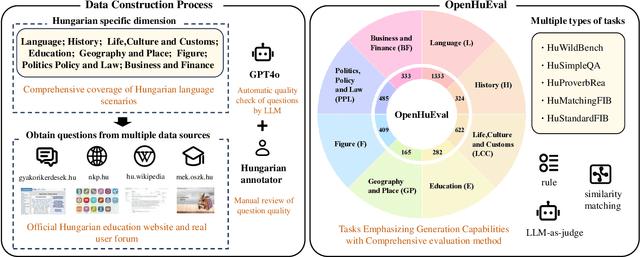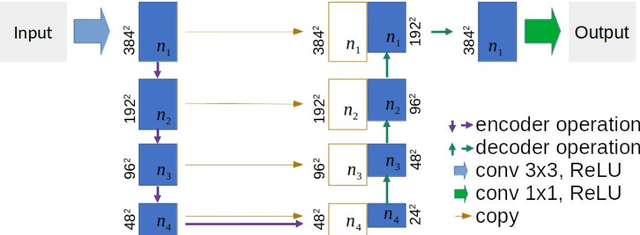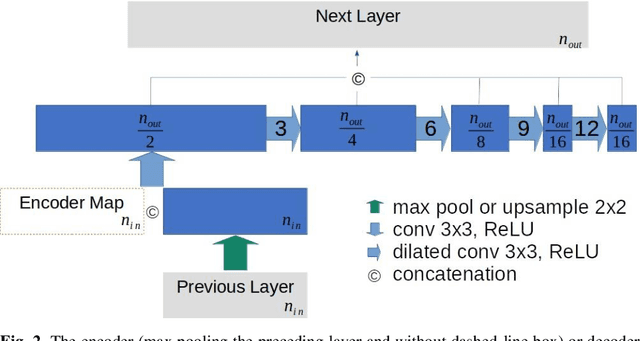Jingchao Wang
Unlocking the Potential of MLLMs in Referring Expression Segmentation via a Light-weight Mask Decode
Aug 06, 2025Abstract:Reference Expression Segmentation (RES) aims to segment image regions specified by referring expressions and has become popular with the rise of multimodal large models (MLLMs). While MLLMs excel in semantic understanding, their token-generation paradigm struggles with pixel-level dense prediction. Existing RES methods either couple MLLMs with the parameter-heavy Segment Anything Model (SAM) with 632M network parameters or adopt SAM-free lightweight pipelines that sacrifice accuracy. To address the trade-off between performance and cost, we specifically propose MLLMSeg, a novel framework that fully exploits the inherent visual detail features encoded in the MLLM vision encoder without introducing an extra visual encoder. Besides, we propose a detail-enhanced and semantic-consistent feature fusion module (DSFF) that fully integrates the detail-related visual feature with the semantic-related feature output by the large language model (LLM) of MLLM. Finally, we establish a light-weight mask decoder with only 34M network parameters that optimally leverages detailed spatial features from the visual encoder and semantic features from the LLM to achieve precise mask prediction. Extensive experiments demonstrate that our method generally surpasses both SAM-based and SAM-free competitors, striking a better balance between performance and cost. Code is available at https://github.com/jcwang0602/MLLMSeg.
GTR-CoT: Graph Traversal as Visual Chain of Thought for Molecular Structure Recognition
Jun 09, 2025



Abstract:Optical Chemical Structure Recognition (OCSR) is crucial for digitizing chemical knowledge by converting molecular images into machine-readable formats. While recent vision-language models (VLMs) have shown potential in this task, their image-captioning approach often struggles with complex molecular structures and inconsistent annotations. To overcome these challenges, we introduce GTR-Mol-VLM, a novel framework featuring two key innovations: (1) the \textit{Graph Traversal as Visual Chain of Thought} mechanism that emulates human reasoning by incrementally parsing molecular graphs through sequential atom-bond predictions, and (2) the data-centric principle of \textit{Faithfully Recognize What You've Seen}, which addresses the mismatch between abbreviated structures in images and their expanded annotations. To support model development, we constructed GTR-CoT-1.3M, a large-scale instruction-tuning dataset with meticulously corrected annotations, and introduced MolRec-Bench, the first benchmark designed for a fine-grained evaluation of graph-parsing accuracy in OCSR. Comprehensive experiments demonstrate that GTR-Mol-VLM achieves superior results compared to specialist models, chemistry-domain VLMs, and commercial general-purpose VLMs. Notably, in scenarios involving molecular images with functional group abbreviations, GTR-Mol-VLM outperforms the second-best baseline by approximately 14 percentage points, both in SMILES-based and graph-based metrics. We hope that this work will drive OCSR technology to more effectively meet real-world needs, thereby advancing the fields of cheminformatics and AI for Science. We will release GTR-CoT at https://github.com/opendatalab/GTR-CoT.
Imagination-Limited Q-Learning for Offline Reinforcement Learning
May 18, 2025Abstract:Offline reinforcement learning seeks to derive improved policies entirely from historical data but often struggles with over-optimistic value estimates for out-of-distribution (OOD) actions. This issue is typically mitigated via policy constraint or conservative value regularization methods. However, these approaches may impose overly constraints or biased value estimates, potentially limiting performance improvements. To balance exploitation and restriction, we propose an Imagination-Limited Q-learning (ILQ) method, which aims to maintain the optimism that OOD actions deserve within appropriate limits. Specifically, we utilize the dynamics model to imagine OOD action-values, and then clip the imagined values with the maximum behavior values. Such design maintains reasonable evaluation of OOD actions to the furthest extent, while avoiding its over-optimism. Theoretically, we prove the convergence of the proposed ILQ under tabular Markov decision processes. Particularly, we demonstrate that the error bound between estimated values and optimality values of OOD state-actions possesses the same magnitude as that of in-distribution ones, thereby indicating that the bias in value estimates is effectively mitigated. Empirically, our method achieves state-of-the-art performance on a wide range of tasks in the D4RL benchmark.
AFCL: Analytic Federated Continual Learning for Spatio-Temporal Invariance of Non-IID Data
May 18, 2025Abstract:Federated Continual Learning (FCL) enables distributed clients to collaboratively train a global model from online task streams in dynamic real-world scenarios. However, existing FCL methods face challenges of both spatial data heterogeneity among distributed clients and temporal data heterogeneity across online tasks. Such data heterogeneity significantly degrades the model performance with severe spatial-temporal catastrophic forgetting of local and past knowledge. In this paper, we identify that the root cause of this issue lies in the inherent vulnerability and sensitivity of gradients to non-IID data. To fundamentally address this issue, we propose a gradient-free method, named Analytic Federated Continual Learning (AFCL), by deriving analytical (i.e., closed-form) solutions from frozen extracted features. In local training, our AFCL enables single-epoch learning with only a lightweight forward-propagation process for each client. In global aggregation, the server can recursively and efficiently update the global model with single-round aggregation. Theoretical analyses validate that our AFCL achieves spatio-temporal invariance of non-IID data. This ideal property implies that, regardless of how heterogeneous the data are distributed across local clients and online tasks, the aggregated model of our AFCL remains invariant and identical to that of centralized joint learning. Extensive experiments show the consistent superiority of our AFCL over state-of-the-art baselines across various benchmark datasets and settings.
Progressive Language-guided Visual Learning for Multi-Task Visual Grounding
Apr 22, 2025Abstract:Multi-task visual grounding (MTVG) includes two sub-tasks, i.e., Referring Expression Comprehension (REC) and Referring Expression Segmentation (RES). The existing representative approaches generally follow the research pipeline which mainly consists of three core procedures, including independent feature extraction for visual and linguistic modalities, respectively, cross-modal interaction module, and independent prediction heads for different sub-tasks. Albeit achieving remarkable performance, this research line has two limitations: 1) The linguistic content has not been fully injected into the entire visual backbone for boosting more effective visual feature extraction and it needs an extra cross-modal interaction module; 2) The relationship between REC and RES tasks is not effectively exploited to help the collaborative prediction for more accurate output. To deal with these problems, in this paper, we propose a Progressive Language-guided Visual Learning framework for multi-task visual grounding, called PLVL, which not only finely mine the inherent feature expression of the visual modality itself but also progressively inject the language information to help learn linguistic-related visual features. In this manner, our PLVL does not need additional cross-modal fusion module while fully introducing the language guidance. Furthermore, we analyze that the localization center for REC would help identify the to-be-segmented object region for RES to some extent. Inspired by this investigation, we design a multi-task head to accomplish collaborative predictions for these two sub-tasks. Extensive experiments conducted on several benchmark datasets comprehensively substantiate that our PLVL obviously outperforms the representative methods in both REC and RES tasks. https://github.com/jcwang0602/PLVL
OpenHuEval: Evaluating Large Language Model on Hungarian Specifics
Mar 27, 2025



Abstract:We introduce OpenHuEval, the first benchmark for LLMs focusing on the Hungarian language and specifics. OpenHuEval is constructed from a vast collection of Hungarian-specific materials sourced from multiple origins. In the construction, we incorporated the latest design principles for evaluating LLMs, such as using real user queries from the internet, emphasizing the assessment of LLMs' generative capabilities, and employing LLM-as-judge to enhance the multidimensionality and accuracy of evaluations. Ultimately, OpenHuEval encompasses eight Hungarian-specific dimensions, featuring five tasks and 3953 questions. Consequently, OpenHuEval provides the comprehensive, in-depth, and scientifically accurate assessment of LLM performance in the context of the Hungarian language and its specifics. We evaluated current mainstream LLMs, including both traditional LLMs and recently developed Large Reasoning Models. The results demonstrate the significant necessity for evaluation and model optimization tailored to the Hungarian language and specifics. We also established the framework for analyzing the thinking processes of LRMs with OpenHuEval, revealing intrinsic patterns and mechanisms of these models in non-English languages, with Hungarian serving as a representative example. We will release OpenHuEval at https://github.com/opendatalab/OpenHuEval .
DynCIM: Dynamic Curriculum for Imbalanced Multimodal Learning
Mar 09, 2025Abstract:Multimodal learning integrates complementary information from diverse modalities to enhance the decision-making process. However, the potential of multimodal collaboration remains under-exploited due to disparities in data quality and modality representation capabilities. To address this, we introduce DynCIM, a novel dynamic curriculum learning framework designed to quantify the inherent imbalances from both sample and modality perspectives. DynCIM employs a sample-level curriculum to dynamically assess each sample's difficulty according to prediction deviation, consistency, and stability, while a modality-level curriculum measures modality contributions from global and local. Furthermore, a gating-based dynamic fusion mechanism is introduced to adaptively adjust modality contributions, minimizing redundancy and optimizing fusion effectiveness. Extensive experiments on six multimodal benchmarking datasets, spanning both bimodal and trimodal scenarios, demonstrate that DynCIM consistently outperforms state-of-the-art methods. Our approach effectively mitigates modality and sample imbalances while enhancing adaptability and robustness in multimodal learning tasks. Our code is available at https://github.com/Raymond-Qiancx/DynCIM.
EIT: Efficiently Lead Inductive Biases to ViT
Mar 14, 2022



Abstract:Vision Transformer (ViT) depends on properties similar to the inductive bias inherent in Convolutional Neural Networks to perform better on non-ultra-large scale datasets. In this paper, we propose an architecture called Efficiently lead Inductive biases to ViT (EIT), which can effectively lead the inductive biases to both phases of ViT. In the Patches Projection phase, a convolutional max-pooling structure is used to produce overlapping patches. In the Transformer Encoder phase, we design a novel inductive bias introduction structure called decreasing convolution, which is introduced parallel to the multi-headed attention module, by which the embedding's different channels are processed respectively. In four popular small-scale datasets, compared with ViT, EIT has an accuracy improvement of 12.6% on average with fewer parameters and FLOPs. Compared with ResNet, EIT exhibits higher accuracy with only 17.7% parameters and fewer FLOPs. Finally, ablation studies show that the EIT is efficient and does not require position embedding. Code is coming soon: https://github.com/MrHaiPi/EIT
U-Net Using Stacked Dilated Convolutions for Medical Image Segmentation
Apr 10, 2020



Abstract:This paper proposes a novel U-Net variant using stacked dilated convolutions for medical image segmentation (SDU-Net). SDU-Net adopts the architecture of vanilla U-Net with modifications in the encoder and decoder operations (an operation indicates all the processing for feature maps of the same resolution). Unlike vanilla U-Net which incorporates two standard convolutions in each encoder/decoder operation, SDU-Net uses one standard convolution followed by multiple dilated convolutions and concatenates all dilated convolution outputs as input to the next operation. Experiments showed that SDU-Net outperformed vanilla U-Net, attention U-Net (AttU-Net), and recurrent residual U-Net (R2U-Net) in all four tested segmentation tasks while using parameters around 40% of vanilla U-Net's, 17% of AttU-Net's, and 15% of R2U-Net's.
 Add to Chrome
Add to Chrome Add to Firefox
Add to Firefox Add to Edge
Add to Edge